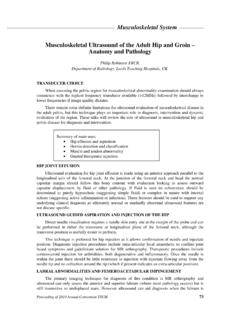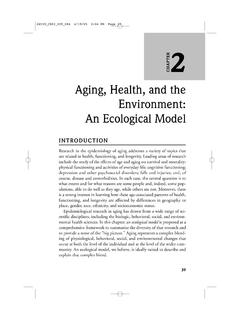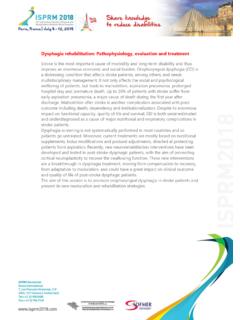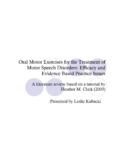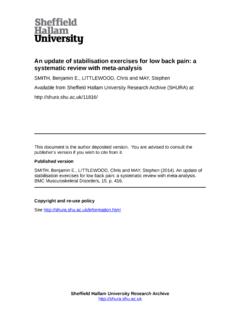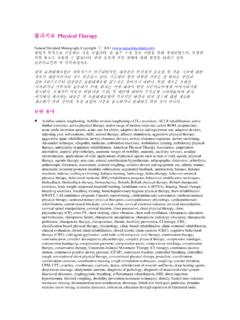Transcription of 52835 CH13 Fernandez - Jones & Bartlett Learning
1 PARTIVPHYSICALEXAMINATION 1/2/09 3:26 PM Page 131 Jones and Bartlett Publishers, LLC. NOT FOR SALE OR 1/2/09 3:26 PM Page 132 Jones and Bartlett Publishers, LLC. NOT FOR SALE OR DISTRIBUTION133 CHAPTER13 Clinical Reasoning in theDiagnosis: HistoryTaking in Patients with HeadachePeter A. Huijbregts, PT, MSc, MHSc, DPT, OCS, MTC, FAAOMPT, FCAMTROLE OF HISTORY TAKING IN THE CLINICAL EXAMINATIONIn physical therapy, as in other health-care professions, there are five el-ements to patient management. The examination is followed by evalu-ation of the examination findings, establishing a diagnosis, producing aprognosis and developing a plan of care, and, finally, performing the in-terventions (American Physical Therapy Association [APTA], 2001).
2 Theexamination element of this process of care usually consists of historytaking, systems review, and tests and measures. Unique to professionssuch as physical therapy with a limited scope of practice, a systems re-view is a brief history and physical examination specifically reviewing the cardiopulmonary, integumentary, musculoskeletal, and neuromus-cular systems, but also meant to get an impression of a patient s com-munication ability, affect, cognition, language, and Learning style (APTA,2001).Generally, the role of the examination process is twofold.
3 First, intended to be comprehensive with regard to screening and specifictesting, this process ideally leads to diagnostic classification. A second im-portant role of the physical therapy examination and related to the lim-ited neuromusculoskeletal scope of practice of physical therapy is theidentification of problems outside this scope of practice that require a CHAPTER OUTLINERole of History Taking in theClinical ExaminationDemographicsLocation of PainOnset and Course of HeadacheCharacter and Intensity ofHeadacheAggravating and Easing FactorsNeurologic SymptomsOtolaryngologic SymptomsSystemic SymptomsMedical HistoryMedication HistoryFamily HistoryPrevious Diagnostic TestsPrognostic
4 IndicatorsSystems ReviewClinical Prediction Rules forDiagnosisOutcome MeasuresPain MeasuresDisability MeasuresRed FlagsConclusions and Implications ofHistory 1/2/09 3:26 PM Page 133 Jones and Bartlett Publishers, LLC. NOT FOR SALE OR DISTRIBUTION efit from pharmacologic management as well, indicat-ing the (potential) need for medical limited number of headache types potentiallyamenable to physical therapy management means thatone of the main objectives of the examination will be toidentify whether the presenting headache complaintcan in fact be classified as one of these five headachetypes.
5 Tables the diagnostic criteriafor these headache types. We should note that for cer-vicogenic headache there are two different sets of diag-nostic criteria (Table ). In addition to the criteria inthe International Classification of Headache Disorders(IHS, 2004), Sjaastad et al. and the CervicogenicHeadache International Study Group (1998) establishedcriteria that are in fact used more frequently in the clin-ical et al. (1994) demonstrated that diagnosis of primary headache types using the InternationalClassification of Headache Disordershad adequate inter-rater reliability for clinical use (k= ).
6 However, beforewe become too confident in our ability to diagnoseheadaches using this classification system, we have torealize that this system may seem simple to use but thatthe absence of confirming imaging, electrophysiologic, orlaboratory tests for the primary headache disordersmeans that the clinician is frequently in the position ofneeding to consider or rule out a secondary headachetype that may be similar in appearance to the primaryheadache disorder based on history and examinationfindings alone (Bartleson, 2006). For an extended out-line of headache diagnosis, see Chapter of these secondary headache disorders mim-icking the headache types that therapists can, in fact,manage may be serious or even life threatening and re-quire urgent medical or surgical referral.
7 Because the diagnostic procedures confirming such secondaryheadaches are outside the diagnostic scope of practice ofthe therapist, the second main objective of the history and of the examination process in general becomesnot only the identification of a headache (or other undiagnosed) disorder not amenable to physical ther-apy intervention but also and more specifically the identification of those headache emergencies that re-quire urgent referral (Chapter 3). Within the context ofhistory taking, the clinician should seek to identify redflag symptoms indicating serious pathology.
8 The historycomponent of the systems review may also yield indica-tions of pathology that may or may not be related to the presenting complaint of headache but that still require for medical or surgical diagnosis and, perhaps, co-management. The systems review component of theexamination plays an important role in detecting indica-tions for such referral (APTA, 2001).Obtaining a comprehensive history is paramount toany diagnostic process but perhaps even more so in pa-tients presenting with headache. Bartleson (2006) notedthat in patients with complaint of headache, history tak-ing in combination with the general and neurologic ex-aminations constitutes the diagnostic gold , the primary headache disorders defined in the International Classification of Headache Disorders(International Headache Society [IHS], 2004) have noavailable confirming diagnostic tests or (2005) further emphasized the importance of his-tory taking by noting that most patients presenting withheadache often have few signs on physical examina-tion.
9 In children, the role of the history is perhaps evenmore important. Dooley et al. (2003) reported that thehistory provided the correct diagnosis and managementin 100% of 150 children presenting with there is some variation in a worldwide context, physical therapy interventions are generallylimited to manual therapy, education, exercise, andmodality-based treatments, thereby excluding pharma-cologic and surgical interventions. In this aspect, physi-cal therapy is similar to other professions that might beinvolved in the diagnosis and management of patientswith headache, such as chiropractic and massage discussed in this chapter, this makes the diagnosticprocess in such professions a bit is mounting research evidence (or at the veryleast a plausible pathophysiologic rationale) that manualtherapy interventions and other modalities within thescope of practice of physical therapy are effective in the management of five distinct types of headaches.
10 Ofthe primary headaches, the scientific literature indicatesthat tension-type headache, and to a lesser extent mi-graine, may have an underlying neuromusculoskeletalcontribution (Fern ndez-de-las-Pe as et al., 2006a,2006b, 2006c; Tuchin et al., 2000; Simons et al., 1999;Tuchin, 1999). Secondary headaches with a neuro-musculoskeletal etiology that are, therefore, potentiallyamenable to interventions within the physical therapyscope of practice include cervicogenic headache, occipi-tal neuralgia, and headache associated with temporo-mandibular disorder (Issa & Huijbregts, 2006; Bronfort et al.)










